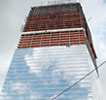A New Era for Fire Protection and Life Safety
A phoenix rises
Seven World Trade Center (7WTC) was the last building to collapse on September 11, 2001, after burning for seven hours. Today, it's the first to be rebuilt at Ground Zero. The 52-story building, designed by the New York office of SOM for Silverstein Properties, will enclose 1.7 million square feet of commercial office space.
SOM, structural engineers WSP Cantor-Seinuk, and m/e/p and fire-protection engineers Jaros, Baum & Bolles examined a host of options as they developed a plan for 7WTC. SOM's Galioto describes the team's strategy for designing a structure at Ground Zero, a site with arguably the world's most infamous parcel of real estate, as comprising three concentric rings of defense-suppression, protection, and evacuation. Within each ring, the design team fortified life-safety features by inserting what Galioto refers to as redundancy and diversity, in an effort to ensure, as much as is technologically possible, continuous performance of all systems in every likely circumstance.
"The first ring of defense calls for suppressing the fire where it starts, creating greater opportunity for evacuation and less property damage," Galioto explains. In the wake of 9/11, fire experts have raised concerns about the reliability, or rather the vulnerability, of sprinkler systems. SOM has rigorously applied the principles of redundancy and diversity to mitigate these concerns. "With regard to redundancy, we followed several courses simultaneously. We increased the density of sprinkler heads, constituting an upgrade from ‘light hazard' to ‘ordinary hazard.' " (The 2002 NFPA 13 handbook of "Codes and Standards" classifies types of hazards requiring sprinklers as light, ordinary, or high.)
The second redundancy addresses the reliability of water supply to the sprinklers. Most building codes require only one riser to feed all the sprinklers. SOM doubled the supply by inserting a separate standpipe in both stairwells. Each supply alternates floors: One provides water to the even-numbered floors, the other to the odd-numbered ones. "This ensures that if one fails, no two consecutive floors will be without water," he continues, thus increasing the ability to suppress the vertical spread of the fire. "There has never been a fire in a high-rise commercial building in the U.S. that has spread in this manner if the sprinklers were functioning properly." He cites the fierce 1991 Meridian Plaza fire in Philadelphia as an example. "The building was in the process of having a sprinkler system installed. The fire spread vertically through the floors where sprinklers had not been installed. When it reached the levels where new sprinklers were operative, the fire was suppressed."











